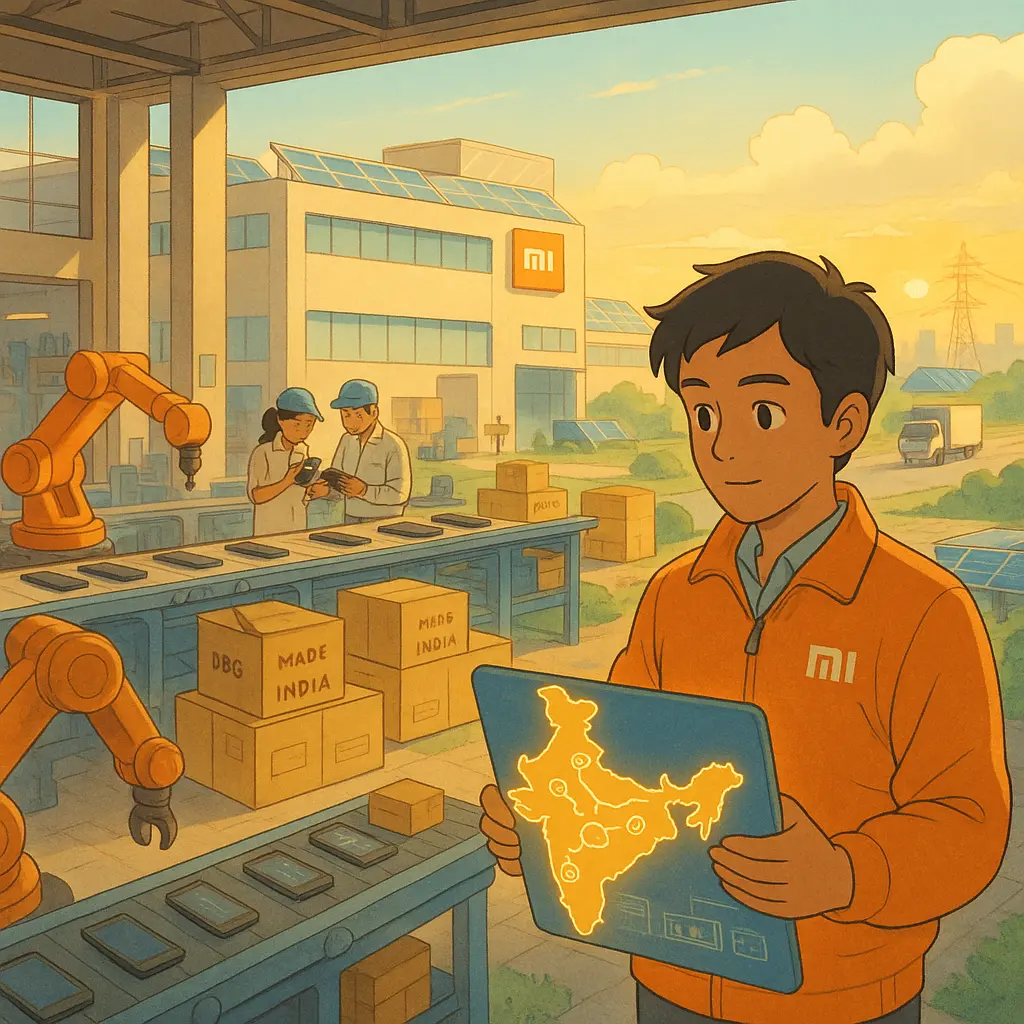
Xiaomi’s localized supply chain in India was a bold move that paid off tremendously for the company. But why did the company choose this particular strategy, and how can supply chains apply the same logic to building stronger systems?
Key Nuggets
- Xiaomi’s localized supply chain in India was designed to cut production costs, reduce import duty pressure, and respond more quickly to demand.
- Government rules, rising tension between India and China, and new duty hikes pushed Xiaomi to deepen its local footprint.
- The steps that worked for Xiaomi can guide African supply chains that want steady output in fast-growing markets.
Background Story Behind Xiaomi’s Localized Supply Chain in India
Xiaomi’s localized supply chain in India began with a simple aim: build phones close to buyers to speed up delivery and protect margins. It was a choice that would later shape the company’s success, not just in India but beyond.
The first push came in 2014.
India was entering a smartphone boom, with buyers moving from basic devices to budget Android phones at a rapid pace. The market was expected to go from 140 million users in 2014 to around 651 million by 2019.
Xiaomi saw this and wanted to capitalize on it. The strategy was to hit price points that Indian families could afford. But to do that, the Chinese tech giant needed lower production costs.
Importing finished phones from China was subject to heavy duties.
A phone brought into India as a complete unit could be subject to taxes that would wipe out Xiaomi’s price advantage. The company’s leadership recognized that such duties could slow growth, so they responded by assembling phones locally.
Government policy added more urgency. India launched the Make in India program, inviting global brands to manufacture goods in the country. Xiaomi saw the direction of policy early and chose to match it.
In the words of one report, the company worked to “play by the Indian government’s rulebook” because it was easier for growth and to improve trust among local partners.
Another push came from longer lead times, which risked empty inventories and angry buyers.
Phones shipped from China could take weeks to arrive. But Xiaomi was running online flash sales that required quick restocking.
Getting a local assembly cut the time from weeks to days and ensured speed was on the table.
Rising tension between India and China after 2020 added further pressure. India blocked many Chinese apps, and firms with Chinese ownership drew extra scrutiny. Xiaomi was not banned, but it needed to show clear value to India.
A deep local presence made the company harder to target and easier to keep in business.
All these forces, including cost, duty pressure, demand speed, and politics, pulled Xiaomi toward a local supply chain.
Read More: Lessons From Walmart’s Sourcing Shift From China to India.
How Xiaomi Approached Its Localized Supply Chain in India
Xiaomi began local assembly in 2015 at the Taiwanese-owned Foxconn plant in Andhra Pradesh. And the first phone made in India was launched that same year.
Following that, Xiaomi achieved early wins, including lower duties, faster inventory turnover, and smoother flash sale cycles.
By 2017, Xiaomi had added more factories. Foxconn expanded production, and Flex joined as a second partner. By 2018, the company had seven factories across India. These plants made almost all the phones Xiaomi sold in the country.
As duty rules changed, Xiaomi moved beyond simple assembly. India began increasing duties on parts like chargers, batteries, and displays. Xiaomi responded by sourcing these parts domestically, deepening its local footprint and reducing import risk.
By 2019, more than 95% of Xiaomi’s phones sold in India were assembled there. Many components, including batteries, chargers, and circuit boards, were manufactured in Indian factories.
Xiaomi’s supply chain also worked with new partners, such as Navitasys for batteries and Sunny Opticals for camera modules.
In 2021, Xiaomi added BYD and DBG as new partners, with new plants set up in Tamil Nadu and Haryana. Xiaomi said that adding these partners increased its local output by about 20%, ensuring that 99% of the Xiaomi phones sold in India were made locally.
Read More: How Nestlé’s Digital Procurement Platform Transformed Its Dairy Supply Chain in India.
The Impact of Xiaomi’s Localized Supply Chain
Xiaomi’s India manufacturing strategy changed the smartphone market. Local assembly lowered costs and enabled Xiaomi to offer strong devices at low price points, helping them reach the number one market position.
Local factories also gave Xiaomi speed. When demand spiked, nearby plants could raise output. And when flash sales emptied stock, factories could quickly replenish it. This speed was critical in a country where millions of phones are sold in short windows.
By the end of 2015, Xiaomi had become the third-largest smartphone vendor in India.
The impact went beyond lowering costs. Xiaomi created jobs across its partners, including factories, the retail network, and support teams. By 2020, Xiaomi was responsible for more than 60,000 workers in India.
Many component suppliers grew after Xiaomi began buying from them, thereby boosting output in India’s broader electronics ecosystem.
Xiaomi’s supply chain also helped maintain stability amid global disruptions. When the pandemic hit global shipping, Xiaomi’s India factories continued production. This helped the company stay active even while transport systems slowed.
Do you want more supply chain stories like this? Subscribe here
Lessons From Xiaomi’s Localized Supply Chain In India
Xiaomi’s “Make in India” journey offers several key lessons for multinational businesses and supply chain strategists:
Lesson 1: Match Government Direction Early
Xiaomi did not wait for strict rules before localizing production. It moved early, aligned with local policy, and built trust, which in turn ensured smoother operations and helped the company avoid problems during tense periods.
As one expert noted, Xiaomi understood that to grow in India, it had to show how it “contributes to the local economy.” When a market signals where it is going, supply chains should move in that direction.
Lesson 2: Local Production Protects Margins
Duty pressure forced brands to rethink import-heavy models. Xiaomi used local assembly to cut costs, enabling it to offer lower prices in a price-sensitive market.
This approach also cut freight costs, customs delays, and long lead times. A local supply chain kept Xiaomi competitive in a crowded smartphone category.
Supply chain professionals can see how location choices can protect margins in markets where small pricing shifts mean lost demand.
Lesson 3: Deep Localization Builds Resilience
Xiaomi’s shift did not stop at local phone assembly. It also began sourcing cameras, batteries, chargers, and circuit boards domestically in India. This way, the company reduced import risk, especially during a period when global shipping slowed.
One report noted that about 75% of Xiaomi’s phone value came from components manufactured in India. That level of local sourcing helped the company remain stable, proving that deep localization—moving from assembly to component sourcing — ensures control and resilience.
Lesson 4: Local Presence Builds Trust
Tension between India and China put pressure on Chinese brands. But in the middle of that, Xiaomi gained goodwill by hiring local workers, opening plants, and adding Indian-made parts.
When a brand creates direct jobs and contributes to local output, public pressure softens. This shields the supply chain during political shifts.
Lesson 5: Spread Factory Partners for Safety
Xiaomi worked with Foxconn, Flex, BYD, and DBG. It was a mix that avoided single-point failure. If one plant faced delays, others could pick up the gap.
Multiple partners also allowed Xiaomi to scale quickly as demand increased. The approach protected its supply chains during shocks and enabled it to grow without delay.
Read More: Why Mattel’s 2007 Toy Recall Happened and the Impact

Obinabo Tochukwu Tabansi is a supply chain digital writer (Content writer & Ghostwriter) helping professionals and business owners across Africa learn from real-world supply chain wins and setbacks and apply proven strategies to their own operations. He also crafts social content for logistics and supply chain companies, turning their solutions and insights into engaging posts that drive visibility and trust.







